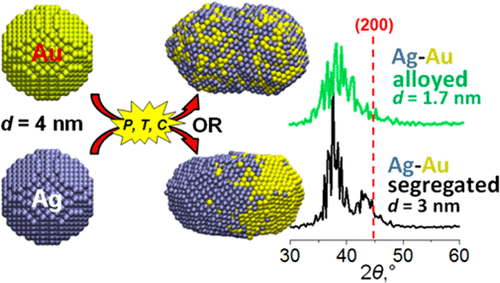Our official English website, www.x-mol.net, welcomes your feedback! (Note: you will need to create a separate account there.)
Surface Composition and Crystallinity of Coalescing Silver–Gold Nanoparticles
ACS Nano ( IF 17.1 ) Pub Date : 2017-11-13 00:00:00 , DOI: 10.1021/acsnano.7b06727 Eirini Goudeli 1 , Sotiris E. Pratsinis 1
ACS Nano ( IF 17.1 ) Pub Date : 2017-11-13 00:00:00 , DOI: 10.1021/acsnano.7b06727 Eirini Goudeli 1 , Sotiris E. Pratsinis 1
Affiliation

|
Bimetallic nanoparticles exhibit catalytic, optical, electronic, and magnetic synergy between their constituent metals. Typically, that synergy is traced to the domain structure and surface characteristics of such particles. Here these characteristics of coalescing Ag–Au nanoparticles of various initial sizes and morphologies (segregated or alloys) are investigated by atomistic molecular dynamics (MD) at different temperatures. Silver atoms exhibit increased mobility over Au and occupy gradually the surface of the coalesced (or sintered) bimetallic particle, consistent with scanning electron microscopy and selective O2 chemisorption experiments for heterogeneous catalysis of ethylene oxidation. The characteristic sintering time of equally sized Ag–Au nanoparticles is similar to that of pure Au but shorter than that of Ag nanoparticles. When the latter coalesce with substantially bigger Au ones, a patchy Ag layer is formed at the Au particle surface. However, when Ag nanoparticles are bigger, then Au is rather embedded into Ag, consistent with microscopy data. Most notably, X-ray diffraction (XRD) patterns of Ag–Au nanoparticles are obtained by MD, distinguishing segregated from alloyed ones. The latter exhibit a weaker XRD reflection of the (200) crystalline plane and, most distinctly, form smaller crystal size (highly polycrystalline) than coalescing pure and segregated Ag and Au nanoparticles, quantitatively explaining the structure of flame-made Ag–Au nanoparticles for biomaterial applications.
中文翻译:

聚结的银-金纳米粒子的表面组成和结晶度
双金属纳米颗粒在其组成金属之间表现出催化,光学,电子和磁性协同作用。通常,这种协同作用可追溯到此类颗粒的畴结构和表面特性。在这里,通过在不同温度下的原子分子动力学(MD)研究了各种初始尺寸和形态(分离或合金)聚结的Ag-Au纳米颗粒的这些特征。银原子在Au上表现出增加的迁移率,并逐渐占据聚结(或烧结)双金属颗粒的表面,这与扫描电子显微镜和选择性O 2一致化学吸附实验,研究乙烯氧化的非均相催化作用。大小相等的Ag-Au纳米颗粒的特征烧结时间与纯Au相似,但比Ag纳米颗粒短。当后者与基本上更大的Au结合时,会在Au颗粒表面形成片状的Ag层。但是,当银纳米粒子较大时,金就会被嵌入进入银,与显微镜数据一致。最值得注意的是,通过MD获得了Ag-Au纳米颗粒的X射线衍射(XRD)图谱,从而区分了合金和合金。后者在(200)晶面上表现出较弱的XRD反射,最明显的是,形成的晶体尺寸(高度多晶)小于聚结的纯净的和分离的Ag和Au纳米粒子,定量地解释了火焰制备的Ag-Au纳米粒子的结构生物材料应用。
更新日期:2017-11-14
中文翻译:

聚结的银-金纳米粒子的表面组成和结晶度
双金属纳米颗粒在其组成金属之间表现出催化,光学,电子和磁性协同作用。通常,这种协同作用可追溯到此类颗粒的畴结构和表面特性。在这里,通过在不同温度下的原子分子动力学(MD)研究了各种初始尺寸和形态(分离或合金)聚结的Ag-Au纳米颗粒的这些特征。银原子在Au上表现出增加的迁移率,并逐渐占据聚结(或烧结)双金属颗粒的表面,这与扫描电子显微镜和选择性O 2一致化学吸附实验,研究乙烯氧化的非均相催化作用。大小相等的Ag-Au纳米颗粒的特征烧结时间与纯Au相似,但比Ag纳米颗粒短。当后者与基本上更大的Au结合时,会在Au颗粒表面形成片状的Ag层。但是,当银纳米粒子较大时,金就会被嵌入进入银,与显微镜数据一致。最值得注意的是,通过MD获得了Ag-Au纳米颗粒的X射线衍射(XRD)图谱,从而区分了合金和合金。后者在(200)晶面上表现出较弱的XRD反射,最明显的是,形成的晶体尺寸(高度多晶)小于聚结的纯净的和分离的Ag和Au纳米粒子,定量地解释了火焰制备的Ag-Au纳米粒子的结构生物材料应用。



























 京公网安备 11010802027423号
京公网安备 11010802027423号